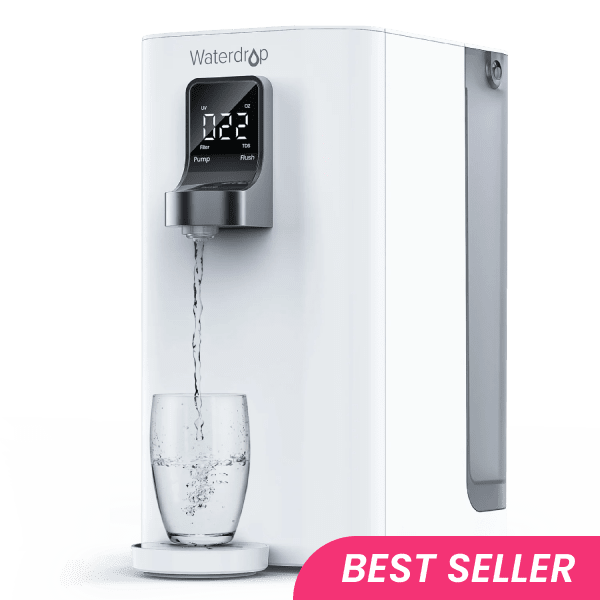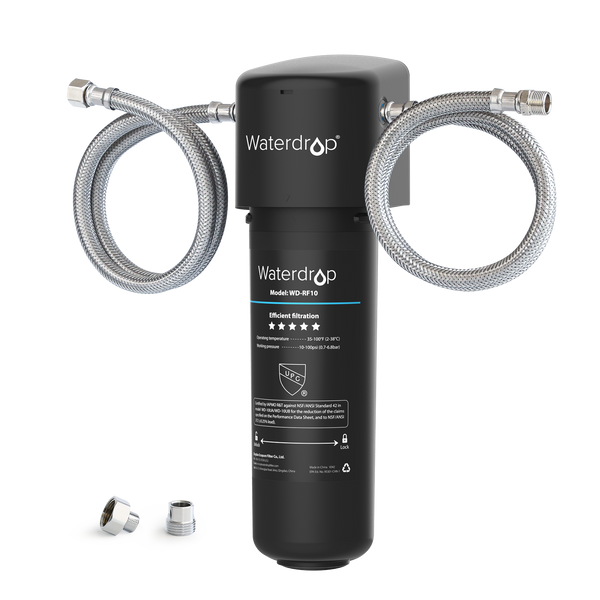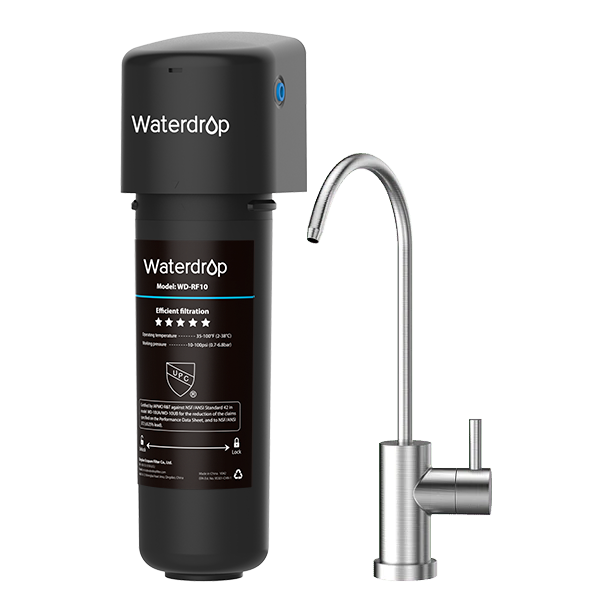Purified VS Distilled VS Tap Water: What's The Difference?
by Dr. Jonathan Doyle - Updated February 09, 2023
We all understand the importance and the health benefits of drinking water, but which type of water should we drink? Today’s article will introduce the difference between purified water, distilled water, and tap water. You can make your water decisions based on the information we provide.
What Is Purified Water?
Purified water is water that has been treated with water treatment systems to remove the impurities from water. Both tap water and groundwater are suitable to make purified water, meaning the purified water is pretty accessible for all households.
The major contaminants that are removed from water through the water purification process include various chemical pollutants, bacteria, fungi, algae, heavy metals, and parasites. Water purification can be achieved through several methods:
- Filtration
- Sedimentation
- Coagulation
- Disinfection
These four methods vary in the ways how they purify water but could yield similar results for purified water. Only water that is lower than 10 ppm can be considered purified water, which means about 99 percent of the impurities should be removed from the water.
Health Benefits of Purified Water
As news about the water crisis keeps showing up, the benefits of drinking purified water have been noticed by more and more people. Though the tap water has been treated before supplying to your home tap, the trace chemical residue from water treatment systems and the heavy metal particles from piping systems bring potential health risks.
The chlorine residue for example. As a standard disinfect chemical, chlorine is widely used in water treatment plants around the world. However, the chlorine leftover in the tap water might lead to a series of health problems including colorectal cancer. Besides the trace chemical leftovers, purified water can protect you from water contaminants like bacteria and heavy metals, which all contribute to your overall health conditions.
The major reason why many people opt for bottled water or sugary beverages is the bad taste and odor from tap water. The purified water that is treated through activated carbon filtration systems can effectively remove the bad taste and odor in water, which allows you to enjoy safe and tasty drinking water anytime.
Learn more about the activated carbon for water filtration here.
How is Water Purified?
Purified water has been subjected to different processes, including reverse osmosis, adsorption, distillation, disinfection, etc.
In the case of disinfection, disinfectant chemicals are added, which filters out harmful microorganisms.
Granular activated carbon is an activated carbon with a large surface area and can absorb most toxic compounds. It is used in municipal water filtration to remove bad taste and odors.
In reverse osmosis, water is forced through a semi-permeable membrane with the application of mechanical pressure. This ensures that the contaminants and pure water molecules are separated on either side of the membrane. In theory, it is the most thorough large-scale water purification method known.
What Is Distilled Water?
Distilled water is a form of purified water. It is obtained from distillation, specifically through boiling and steam condensing. First, water is boiled by subjecting it to a heating source. The steam formed rises up and touches the surface of the cold container before it eventually condenses into pure water. This process removes and separates the impurities from the pure water.
Most people do not prefer distilled water for drinking because naturally occurring beneficial minerals are absent. Drinking such water can lead to nutritional deficiency and issues with the teeth. Experts have reported the possible leaching of minerals in the teeth into distilled water with no minerals, thus making it unsafe for drinking.
Is Purified Water The Same as Distilled Water?
Based on the above, almost nothing separates distilled water and purified water except the purification method. For distilled water, distillation is the purification method. However, purified water can be obtained via other different methods.
Another significant difference between both types of water associated with the purification process is that distilling water produces unmineralized water, i.e., water without magnesium, calcium, and other naturally occurring minerals. Conversely, purified water contains these essential minerals without those harmful chemicals and impurities.
Distilled Water Shortage
The purest form of water has been proven to be distilled water. That is why it is used in industrial and medical processes.
In medical processes, distilled water is used in sterilizing medical equipment and as a solvent in manufacturing medications and pharmaceuticals. It is also used in laboratory and research experiments to ensure the accuracy of results.
The automotive industry requires distilled water as essential components of car batteries and cooling units. The cosmetic and personal care industry uses water in personal care products like shampoos, cosmetics, and others. Distilled water is also preferred for cleaning and rinsing in industries requiring high purity levels, e.g., electronics manufacturing. Home appliances like steam irons, humidifiers, and others all need distilled water to function effectively.
Overall, the shortage of distilled water is due to the combination of high demand and supply chain issues.
Homemade Distilled Water
You can distill water at home by heating tap water until it turns to vapor. Once the vapor cools down and condenses, all the mineral residue is left behind, giving you pure distilled water. Follow the steps below to make distilled water at home:
- Get a large clean pot and fill it with tap water.
- Place the filled pot on the stove.
- Place a heat-resistant glass bowl in the pot such that it is floating on the water’s surface.
- Turn on the heat and leave until the water is boiling properly.
- Cover the pot with a lid placed upside-down, with the handle over the glass bowl.
- Reduce the heat and leave it until the water simmers for about 30 minutes.
- With the water boiling, observe the steam rising and condensing on the lid before dripping into the glass bowl.
- Wait for this process to complete before turning off the heat.
- Leave the distilled water for some time to cool down.
- Transfer the distilled water into a clean, airtight container.
- It is best stored in a cool, dry, and clean place.
Please ensure the pot, lid, and glass bowl are clean to prevent contamination of the distilled water by impurities. In addition, it is advisable not to drink distilled water because it lacks the essential nutrients and minerals the body needs to function optimally.
What Is Tap Water?
Tap water is the municipally supplied water that you get from your water tap. The sources of tap water in the U.S. are primarily lakes, rivers, and groundwater, which depends completely on where you live in. From the source, water will go through a series of water treatment processes before pumping into your home.
Potential Contaminants in Tap Water
Though city water is regulated by authorities like the EPA, its safety is questionable. The city water crisis cases are still being reported occasionally. The common contaminants found in the tap water include chlorine, fluoride, copper, iron, lead, arsenic, pesticides, herbicides, uranium, and more, which each one of them could cause serious health problems.
Long term exposure to high levels of copper can result in liver damage and kidney disease, and exposure to lead, on the other hand, can lead to permanent damage to the brain, kidney, and other critical body systems, especially in developing children and pregnant women.
The byproducts of the water treatment process and trace pharmaceuticals have also been found in water supplies. Though both of these impurities are trace amounts in water, the WHO has warned that these substances are not supposed to be consumed on a daily basis.
What Type of Water Should I Drink?
There is no absolute answer when choosing which type of water is the best to drink. The water choices are highly based on personal preferences. Yet, we do recommend drinking water that gets treated through a reverse osmosis system. The safe water quality for drinking is the main reason.
The Waterdrop Reverse Osmosis System X12 offers a high-speed, tankless water filtration at an impressive 1200G with an 11-stage precision filtration mechanism, capable of removing contaminants such as lead, chlorine, and PFAS, while enhancing water with essential alkaline minerals like calcium and magnesium.
It not only improves health, taste of food and beverages, but can also alleviate stomach acid discomfort. Boasting a smart design, the system includes a digital faucet with functions such as precise water dispensing and TDS/filter lifespan monitoring. It's engineered for space-saving and simple DIY installation, re-mineralizing water to create natural-tasting, fresh, and healthy water accessible directly from your kitchen.
Key Features:
|
As we have mentioned before, the filtration accuracy of an RO system is 0.0001 microns, meaning that almost all of the contaminants in water can be filtered out. If you are concerned about the removal of beneficial minerals in the water, you can add an additional external remineralization filter onto your RO system to add back minerals. That also explains why we do not recommend drinking distilled water for its lack of minerals.
Tap water is not recommended to drink directly. If you would like to drink tap water, you should boil it before drinking. Boiling is one disinfect method that can help remove certain bacteria from tap water. Yet, the heavy metals and other contaminants could not be easily removed through the boiling water.
Remember to always check the local water quality to prevent contaminated water consumption. If you have health problems such as cardiovascular disease or kidney disease, you should consult with your doctors regarding which type of water is suitable to drink for you.
Recommended Reading:
How to Remineralize Reverse Osmosis Water?
Contaminants Detected in Fruitland Water Special Service District
30
Contaminants
EXCEED EWG HEALTH GUIDELINES
EXCEED EWG HEALTH GUIDELINES
30 Total Contaminants in Your Water
Water Provider
Fruitland Water Special Service DistrictPopulation Affected
120,000Water Source
Ground waterExceeds Guidelines
Others Detected
















